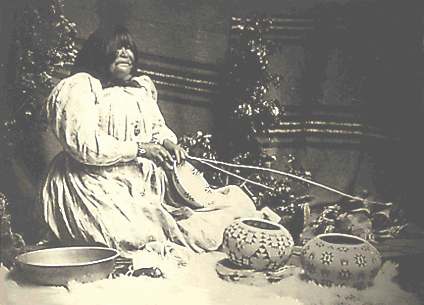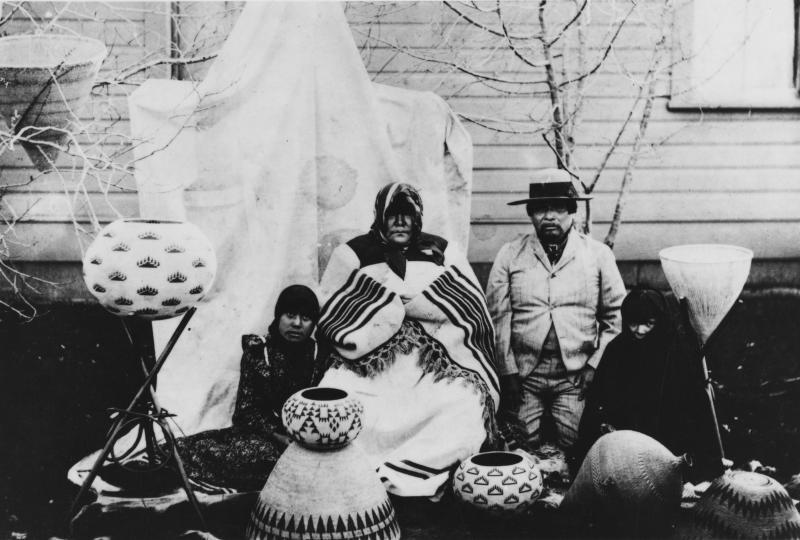 |
| Dat So La Lee "Louisa Keyser" Nevada Historical Society, Reno n.d. |
Just as a number of the pueblos such as San Il Defonso and Santa Clara in New Mexico were known for their pottery, the Washoe were known for their fine basketry. For the native people of the Great Basin, weaving carries both historical and contemporary significance. In their past, the Shoshone, Paiute, and Washoe people practiced a way of life based in part on the seasonal harvest of wild plant resources, and weaving provided most of their tools used to harvest, prepare, and store these foods. As Euro-American people moved west into the lands of the Great Basin Indian people, ways of life were forced to change. Although native people adopted many Euro-American goods, weaving baskets endured as a symbol of native identity and artistic expression. [1]
As their way of life began to disappear due to the encroachment of the Euro-Americans, the Indians lost their lands, and tribes that were historically unfriendly and who did not speak the same languages were relocated to two reservations at Pyramid and Walker Lakes. Forests were cut down, commercial fishing depleted the fish for the tribes and the Washoe, along with other tribes in the region were decimated. With no support from the government, the Washoe were forced to adapt under the pressures of colonialism. [2]
In 1888, Dat-So-La-Lee married Charlie Keyser, a part Washoe Indian who took his name from the family that owned the Keyser and Elrod Ranch in the Carson Valley. At this time, Lee took the name Louisa Keyser. Charlie was twenty-four years younger than she, and an expert arrow craftsman. [3]
 |
| Dat So La Lee at work Nevada Historical Society 1900 |
There is no doubt, however, the Cohns took advantage of Lee. Although her basketry was revered, like many Native Americans of the day Dat So La Lee was presented by Amy Cohn as the noble savage through her lectures. "To the whole audience there was no incongruity in having a white woman explain the basket's symbols, while the weaver herself remained silent." [4] In addition, Dat So La Lee's image was displayed on flyers as a simple-minded, unattractive native with whom Abe Cohn had to deal. Although Lee lived a comfortable life, the Cohns fabricated much of her life to meet their own needs.
Lee perfected the art of basketweaving and is credited with revolutionizing the all aspects of Washoe basket weaving with the invention of a style called Degikup. A degikup basket is a larger basket that has a small, circular base which then coils up and outward to a maximum circumference, which then decreases until the opening at the top is the same diameter as the base. The design on the basket covers most of the surface. In addition, she introduced a dye called Redbud which was used along with a black dye for decoration. Louisa was also influential in establishing the direction for the new curio style and the three coil method as well.
 |
| Louisa Keyser (Dat So La Lee) Degikup Basket 1904-1906 |
Lee died in 1925 and is buried in the Stewart Indian Cemetery in Carson City, Nevada. Her baskets can be found at the Smithsonian, the Nevada State Museum in Carson City, and the Nevada Historical Society in Reno.
Enjoy a short video about Dat So La Lee - http://www.youtube.com/watch?v=cz_Fe283TsQ
 |
| Dat So La Lee with Husband, Charlie Photographer unknown Early 1900s |
_____________________________
1. O.N.E. Online Nevada Encyclopedia. http://www.onlinenevada.org/contemporary_great_basin_basketmakers. (Accessed January 17, 2013).
2.The Washoe Cultural Resources Office. Wa She Shu: The Washoe People Past and Present. http://www.washoetribe.us/images/washoe_tribe_history_v2.pdf. (Accessed January 18, 2013).
3. Nevada Women's History Project. Women's Biographies: Dat So La Lee. http://www.unr.edu/nwhp/bios/women/datsola.htm. (Accessed January 17, 2013).
4. Cohodas, M. In R. Moreno (Ed.), The historical Nevada Magazine: outstanding historical features from the pages of Nevada Magazine (Las Vegas: University of Nevada Press). (1998). 91.
No comments:
Post a Comment